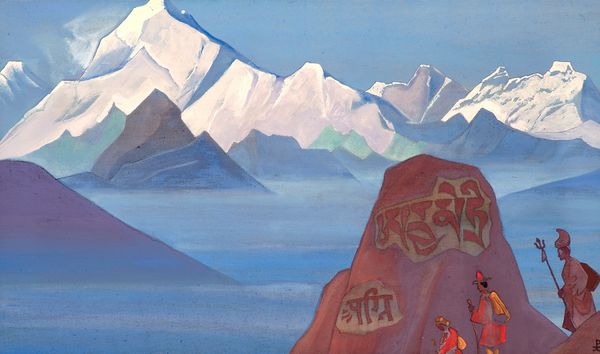
Copyright: Public domain
Editor: So, this is Nicholas Roerich's 1933 oil painting, "Kuan Yin." It's got these striking ice-blue mountains in the background and a woman in the foreground playing a zither. It feels both serene and isolated. What’s your take on this piece? Curator: This painting is incredibly evocative. Beyond its aesthetic qualities, I see Roerich using the figure of Kuan Yin, a bodhisattva of compassion, to explore themes of peace and feminine strength amidst what seems like a harsh, almost post-apocalyptic landscape. Roerich was deeply involved in the Theosophical movement, a spiritual movement with heavy ties to early Feminism, and Kuan Yin was often linked to powerful maternal figures and forces in that socio-religious context. The landscape almost dwarfs the woman. How does this impact the overall tone, in your opinion? Editor: It makes her seem really small and maybe vulnerable. Like she’s a tiny figure of hope in a massive, indifferent world. But there's a sense of determination about her, maybe she's generating the stillness through her music? Curator: Precisely. Roerich was deeply concerned with global peace, and often alluded to an urgent need for harmony through a feminine lens, especially in times of conflict. He painted these ethereal mountainscapes often, symbolizing spiritual challenges and inner journeys, his message becomes so much more acute when a woman is depicted amongst them. Considering the political turmoil of the 1930s, do you think the "Kuan Yin" is a form of quiet resistance or a call to action? Editor: I see what you mean. Maybe both? Like, it's a reminder to find inner peace in chaos but also suggests that compassionate action is vital in times of hardship, that her practice and strength can echo in us. Thanks, I’m definitely looking at this differently now. Curator: It's in thinking through these intersections of art, history and ideology, that we come to a richer understanding of a piece like this. It’s a potent reminder that art can function as both a mirror and a catalyst for social change.
Comments
No comments
Be the first to comment and join the conversation on the ultimate creative platform.













